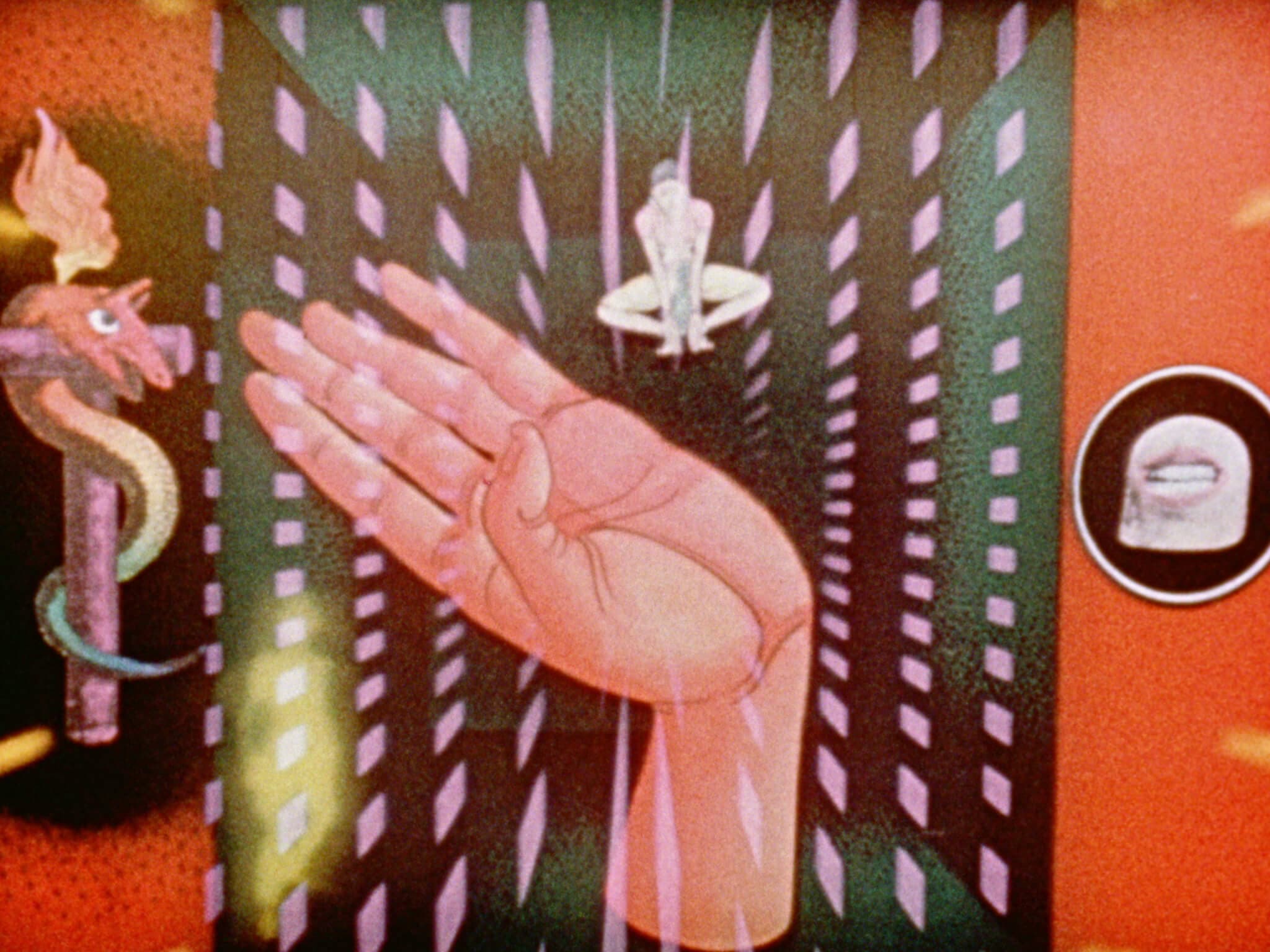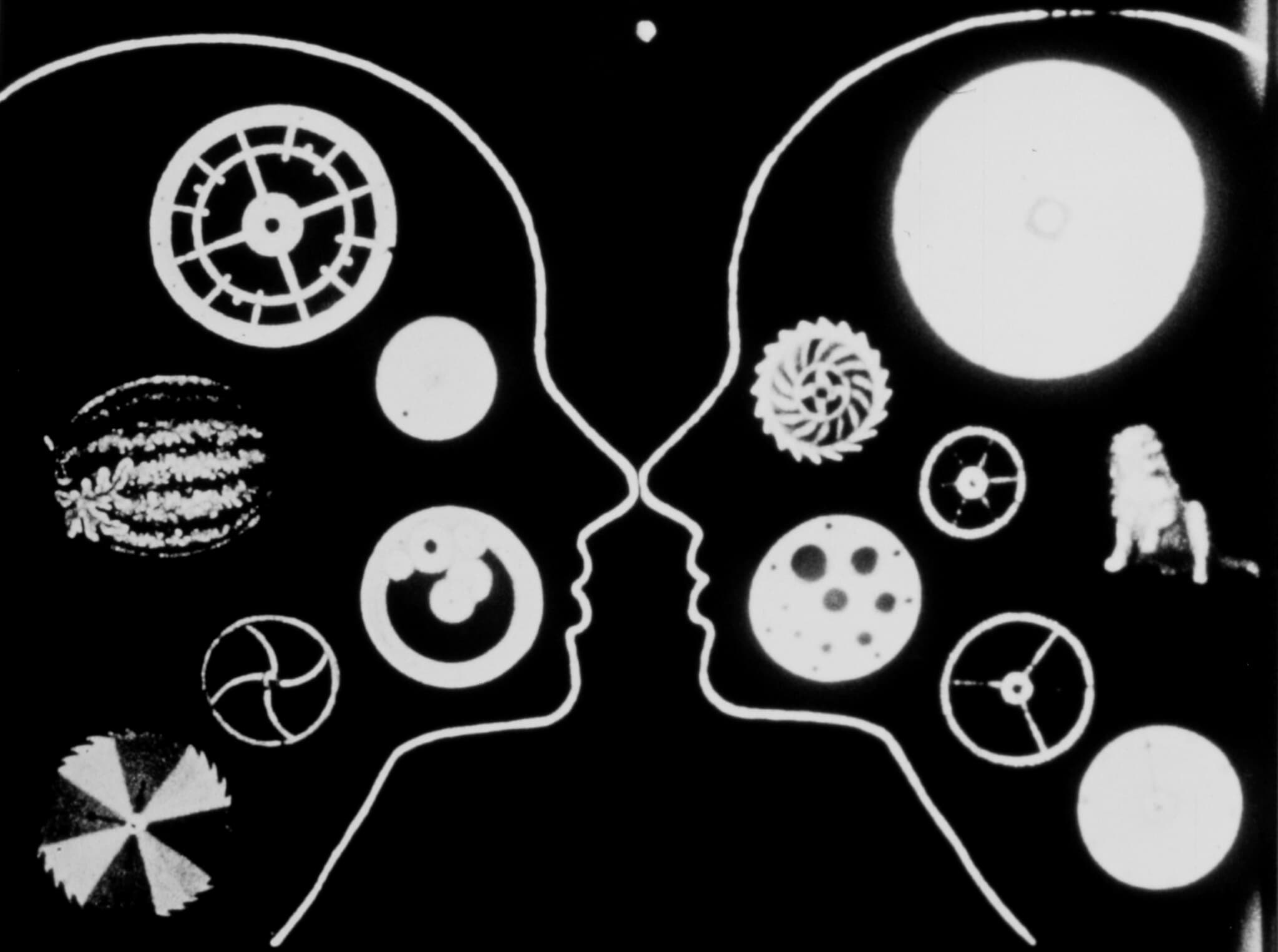In the introduction to his biography on Harry Smith, titled Cosmic Scholar, author John Szwed describes how difficult it is to write a definitive volume on a man like Smith. “Who he was often depended on the medium he was working in,” Szwed explains, noting earlier that Smith was “an anthropologist, a pioneering filmmaker and multimedia artist, a painter, folklorist, poet, jazz scholar, collector, archivist, record producer, magician, translator, and hermetic alchemist.”1 The task of contextualizing a twentieth-century Renaissance man is daunting. “Fragments of a Faith Forgotten: The Art of Harry Smith,” co-organized by the Whitney Museum of American Art and the Carpenter Center for the Visual Arts, where it’s on view until December 1, takes viewers on a winding journey to attempt to locate Smith within his broader context.
“Fragments of a Faith Forgotten” is a fitting title for Smith, who lived a transient and unorthodox life. Born in Portland, Oregon, in 1923, he spent his early years in the Pacific Northwest, where his parents immersed him in the ideas of theosophy alongside ideology from other religions. Unafraid to rebrand himself or embellish a few stories, Smith was also known for occasionally mentioning he could be the bastard son of Aleister Crowley, the English occultist and magician.2 Smith frequently experimented with symbolism and visual motifs across cultures, especially non-Western ones, as demonstrated in the animated film that introduces the exhibition on the third floor, Film No. 11 (Mirror Animations) (c. 1957). We see dancers, an anthropomorphic frog, Satan, and the Buddha, among other figures and objects, moving to the sound of the Thelonious Monk Quartet’s B-side of Misterioso. The film is a fitting primer for a figure who collected memorabilia from the world around him, connecting disparate dots in novel ways.

Still from Harry Smith, Film No. 11 (Mirror Animations), 1957. 16mm film transferred to digital video, color, sound; 3:35 min. Copyright and courtesy of Anthology Film Archives, New York.
As an adolescent, Smith developed a keen interest in anthropology as the field was developing in the twentieth century. His mother taught on the Lummi reservation near Bellingham, Washington, and by the time he was a teenager, Smith had unparalleled access to the Native communities in the Pacific Northwest, documenting ceremonies on the Swinomish reservation and later the Lummi reservation. He would continue his work documenting the Lummi people while studying at the University of Washington.
In the third-floor gallery, we see photographs from this time, showing a young Smith hunched over a recording device memorializing a Lummi ceremony. There are also snapshots from the early 1940s of a Lummi man weaving a gill net and a Swinomish man displaying a string figure for the camera. As one rotates around the large cube in the center of the gallery holding these artifacts displaying Smith’s work from the 1950s and 1960s, it becomes evident that these early years among Native peoples profoundly affected Smith’s creative output. Four prominent string figure pieces from 1960 are displayed alongside illustrations of string figures from around the 1970s.
The 1950s also saw Smith dabbling in his own version of European modernism, namely emulating Wassily Kandinsky in his untitled painting on board (c. 1950–51) and stereo card drawings (c. 1949–50). In these works, basic shapes like circles and triangles overlap and intersect to create complex abstracted fields. But lest one think Smith has settled on European abstraction, around the corner of the cube is Untitled [Demoniac self-portrait] (c. 1952) and The Tree of Life in Four Worlds (1953). In Tree of Life, a collotype with screen print, repeated patterns take on an occultish appearance, stacked and layered in a manner that hints at hidden meanings. As one circles the cube, we see Smith’s fascination with geometry developing as he explores how these basic visual building blocks can take on divergent meanings with different applications.

Harry Smith, (front) Film No. 14 (Late Superimpositions), 1964. 16mm film restored to 35mm film, transferred to digital video, color, sound; 31 min. “Fragments of a Faith Forgotten: The Art of Harry Smith,” installation view, the Carpenter Center for the Visual Arts, Cambridge, MA, through December 1, 2024. Photo by Julia Featheringill. Courtesy of the Carpenter Center for the Visual Arts.
Many of the films that play throughout the exhibition show Smith’s penchant for the surreal and psychedelic (the didactics make mention of “his counterculture youth of marijuana, peyote, and intellectualism”). In Film No. 16 (Oz: The Tin Woodman’s Dream) (c. 1967), familiar yet distorted animated characters from The Wizard of Oz follow a somewhat nonsensical plot loosely tied to its source material—until suddenly, the film cuts to live-action footage and we see a kaleidoscopic view of a real woman in a green mod dress dancing. The mirroring effect, created by using an outward-projecting kaleidoscope Smith called a “teleidoscope,” contorts her body; in some moments, her whole body is visible, while in others she folds into fragmented slivers of green dress and disembodied limbs. The film then shifts to an ominous set of eyes and hands playing with string figures, made more menacing by the continued use of this kaleidoscopic perspective. It’s unclear whether the Tin Man is dreaming of real people or if these are two or three separate plot lines that Smith stitched together imagining their contrast made sense. It should be noted that Smith only numbered his films. He asserted that naming them would be “destructive,” because they would prime the viewer to experience them a certain way, but he allowed his friend Jonas Mekas and the Anthology Film Archive to name them years later.3 He saw much of his work in film as vehicles for “exploration and instruction.”4
One major assertion “Fragments” makes repeatedly is that Smith did not feel constricted to pursue one style of art or even to differentiate between art and music. The exhibition is teeming with sound, and toward the back of the third-floor gallery, three of Smith’s jazz paintings demonstrate the power of this symbiotic relationship. Though these paintings are now lost and can only be viewed as lightbox projections of 35mm slides, they represent the vivacity of the music Smith was listening to at jazz clubs in the Bay Area. Manteca [Jazz Painting] from around 1948–49 corresponds to Dizzy Gillespie’s song by the same name. Szwed notes in his biography on Smith that Kandinsky’s 1926 book Point and Line to Plane (which was translated to English in 1947), in which Kandinsky demonstrates how geometric forms could visually translate Beethoven’s Fifth Symphony, made a lasting impression on Smith.5 Likely inspired by Kandinsky’s thesis and his interest in Victorian theosophy, these jazz paintings were transcriptions of the music into a visual medium. While they may look disorderly, Smith asserted that each stroke corresponded to a note in the song.6 The effect is alluring. A few minutes spent in front of Manteca and one can almost hear the music emerge from the lost painting.

Harry Smith, Manteca [Jazz Painting], 1948–49. Lightbox transparency from 35mm slide of lost original painting. Illustration of Dizzy Gillespie and His Orchestra, Manteca/Cool Breeze (RCA Victor 20-3023, 1948), 78 rpm. Transparency: 27.625 × 21.875 inches. Courtesy of the Estate of Jordan Belson.
Around the same time Smith was working on jazz paintings, he created the work he’s arguably best known for: the Anthology of American Folk Music from 1952. This body of work sparked the folk revival of the 1950s and ultimately earned him a Grammy shortly before his death in 1991. On the first floor of the Carpenter Center, visitors are invited to don a pair of headphones and listen to the recordings Smith compiled of American folk, blues, and country music from 1926 to 1933 on 78rpm records. Their sound is a little scratchy, and perhaps a little difficult to appreciate in the age of Spotify, but in this context Anthology presents Smith as artist-curator, carefully selecting and ordering songs and designing the physical anthology. On three screens, snippets of the accompanying booklet demonstrate Smith’s graphic sensibilities, each numbered in a bold typeface alongside Smith’s truncated descriptions of the song’s narrative. The cover of the accompanying booklet is displayed in the third-floor cube gallery, tying together the works on both floors with this formative collection. On its face, the booklet contains a myriad of Victorian and Americana symbols and images compressed through photostatic reproduction—a visual precursor, art historian Thomas Crow asserts, to the way Pop artists like Andy Warhol flattened and simplified their source material.7

Still from Harry Smith, Film No. 12 (Heaven and Earth Magic Feature), 1957–62. 16mm film transferred to digital video, black and white, sound; 66 min. Copyright and courtesy of Anthology Film Archives, New York.
In a curatorial nod to his contemporaries, Warhol appears in the first-floor gallery as well. On a stand near the back corner of the gallery—easy to miss—a short, silent film plays on loop. Harry Smith (1964) shows its elusive subject gazing out toward and beyond the viewer. Playing on an old television, the film has a fish-bowl feeling, offering a mysterious, murky look at the man behind the curtain. Characteristically, very little insight is offered about what he might be thinking as he plays with a string figure. Meanwhile, the sound of Film No. 12 (Heaven and Earth Magic Feature) (c. 1957–62) fills the gallery. A stop-motion animation that runs sixty-six minutes, the film takes viewers on a surreal odyssey populated by figures and objects cut from nineteenth-century books and department store catalogs, in which a woman receiving a dental procedure ascends into heaven and eventually returns back to Earth. It’s a phantasmal journey that demonstrates how Smith could blend seemingly very different influences into an oddly entrancing vision. In this case, it’s noted that Smith drew on his interest in Kabbalah and his time in Montreal researching epilepsy. The ever-present sound heightens the surreal viewing experience. Much of the time, this gallery space conjures the feeling of sitting at the bottom of a pool, listening to the lapping of water above and the disembodied sounds of cows, birds, and horses. It’s one of a few immersively dreamlike moments in a show that otherwise feels like a textbook come to life.
Though Smith is often billed as a mystic, that’s not the version of Smith that “Fragments” seems to put forth (and, notably, he did not embrace the title of “artist,” though it’s a label that suits him). Instead, “Fragments” presents a visionary man whose roots as a self-taught ethnographer, a student of culture, and a figure of counterculture made him a reflection of his times. But conveying Smith’s genius is a tall order, and faithfully evoking the mystery and chaos of Smith in an exhibition—let alone a review—can be an arduous task. Smith moved around often, at times experiencing homelessness, relying on the kindness of friends to get by; many of his works were lost or destroyed. He also amassed an impressive collection on the cusp of hoarding. The nature of displaying Smith’s legacy in a gallery or museum asserts a sense of order on his life and creative output that arguably did not exist for the man himself. But it’s a laudable task nonetheless. Throughout his life, Harry Smith defied labels and categories to become a model for boundary- and genre-pushing work, elevating the commonplace into the extraordinary.
—1 John Szwed, Cosmic Scholar: The Life and Times of Harry Smith (Farrar, Straus and Giroux, 2023), 6–7. —2 Ibid., 20. —3 Ibid., 90. —4 Ibid., 93. —5 Ibid., 76. —6 Ibid., 77. —7 Thomas Crow, The Long March of Pop: Art, Music, and Design, 1930–1995 (Yale University Press, 2015), 213.
“Fragments of a Faith Forgotten: The Art of Harry Smith” is on view at the Carpenter Center for the Visual Arts through December 1, 2024.




